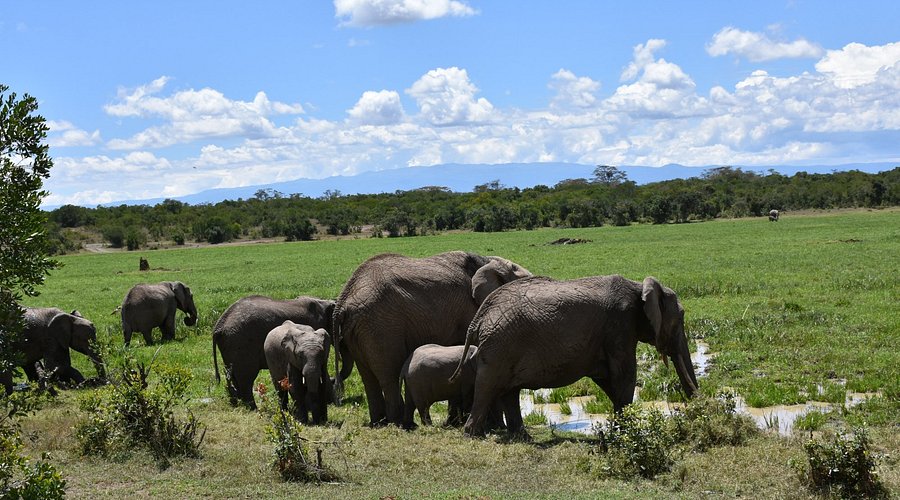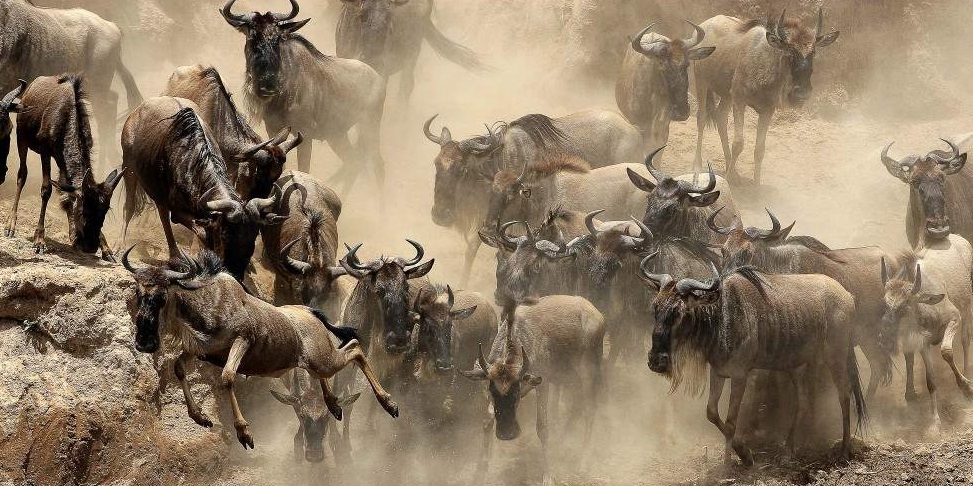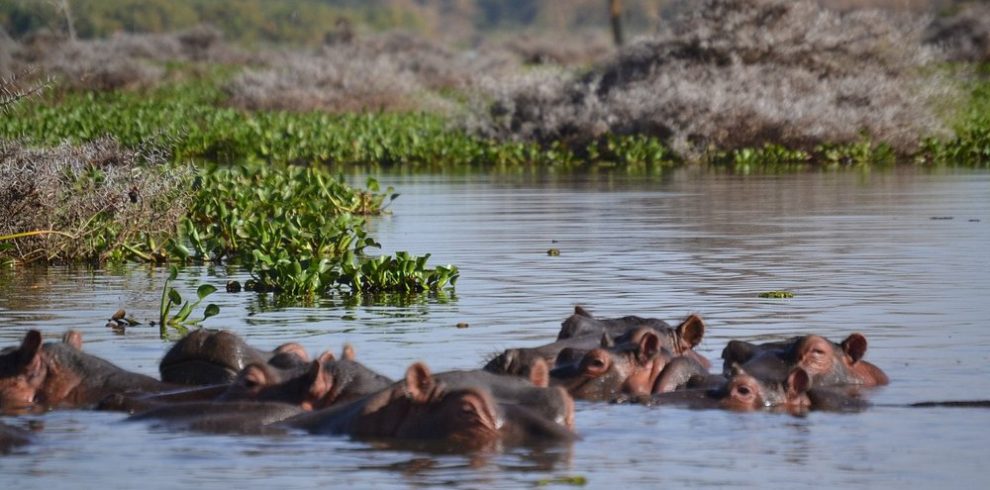Loxodonta africana or the African elephant is one of the most famous species of animals that exist in the world today. The African elephant is the largest living terrestrial animal with a highly developed brain and a structured social system, making the creature very fascinating and majestic. It is the largest land animal and due to that it gets all the attention wherever it is. But as much as it seems like a great giant and awe-inspiring force, there is a lot going on here that puzzles, amazes, and interests in terms of anatomy, physiology, and ecology.
Explore fascinating facts about the African elephant, the largest land animal on Earth. Learn about its intelligence, social behavior, unique trunk, and vital role in the ecosystem. In this article, we will look at five fun facts about African elephants that explain just how unique this amazing animal is and the importance it holds in ecosystems and the difficulties it faces in today’s world.
1. The African Elephant Is the Largest Land Mammal on Earth

Indeed, one of the most facts about the African elephant, is the size. It is worth knowing that the African elephant is one of the biggest creatures belonging to the greatest continent of Africa and is the biggest land animal globally. These magnificent animals can reach 13 feet tall at the shoulder level and can weigh up to 14 thousand pounds, while the male elephants are larger than females. They are either very large or small, which is fascinating but sometimes seems threatening; nevertheless, these features define the animals’ benefits and drawbacks in the wild.
- Immense Size and Strength
An adult male African elephant, usually called a bull, can be as heavy as a small truck weighs. The tusks or the incisors can be up to 10 feet (3 meters) long and can weigh up to 220 pounds (100 kilograms). These tucks are not merely ornaments but are applied in digging for water, stripping bark off trees, and fending off any potential attackers. Besides tusks they have trunks that are strong muscular appendages measuring up to 400 pounds in weight and containing over 150,000 muscle units. This part of the body is really designed by nature to enable the elephant to perform many tasks including drinking, holding food, dust bathing, and expressing its moods.
This makes African elephants the only animals suited for such movements and positioning due to their size and veneration. They can simply knock down trees, pull out plants, and even destroy thickets in the manner they deem fit. Thus, although physical strength is essential to help the characters endure their rather severe climates, it also serves to preserve the balance in ecosystems. African elephants are perceived as being keystone species due to their ability to affect the ecosystems they occupy.
- Advantages and Disadvantages of Size
This has implications such as limited natural enemies and the possibility to cover vast miles in order to find food and water. But, it also has its drawbacks. African elephants require about 300 pounds (136 kilograms) of food daily, a capacity due to their large body size but it is not without a process that occupies much of their time. This constant embracing of food, together with their massive sizes, make them forage large tracts of land to feed on.
2. African Elephants Have Highly Developed Social Structures

One of the most fascinating facts about the African elephant is its highly organized and sophisticated social structure. African elephant is one of the most social animals that have a very complex society and an organized structure. This big animal is a social animal but does not live in large herds; instead, it has a close-knit family unit normally headed by a matriarch who is typically the oldest and most experienced female in the group. These family groupings, or herds are usually made up of several females and their young ones. Males, once they have grown to adulthood, seldom remain in the herd and are either solitary or only occasionally join other males in a group.
- The Role of the Matriarch
In their survivship, the matriarch has the most significant responsibility within the sur Oh, in terms of preserving the tribe-. She is the oldest female having had the opportunity to experience many seasons, migration and many other incidences. She holds incredibly useful knowledge when it comes to navigation – she can pinpoint where there is water during a drought and where there is food during the dry seasons. Similar to the human mothers the cow takes miscellaneous responsibilities when the young ones are in trouble or even in cases like the birth of calves.
These assignments are not only about leading the herd but also looking after the welfare of their mother. Another unique feature is that the African elephants are known to exhibit social emotions; the matriarch always makes sure that everyone stays together and bonded. When elephants are in a state of loss like when a member of their family dies, the matriarch and the other females in the group will nuzzle, touch or walk close to the body of the deceased for many hours.
- Strong Family Bonds and Communication
Elephants are highly social creatures and with the members of their group they have a solid bond. These bonds are sustained through verbal as well as nonverbal interaction or communication. Elephants utilize vocal communication to convey information beyond using visible body language; they lie on the low pitch frequency range and make rumbles and trumpets and growls. Some communicate various things at different times such as warning the rest of the herd danger, organizing movements, or expressing distress.
Elephants also use their trunk, and other parts of the body, for instance touching or caressing one another. As for the touch sense, the elephants are very sensitive to it and use it to comfort other elephants or to remind them of their status in the social status of the group. This elaborate form of communication system effectively enables African elephants to cooperate as well as coordinate in the wild vigorously hence its importance to their survival.
3. The African Elephant’s Trunk Is a Marvel of Evolution

Lying in the geometrical centre of the body and consisting of 230 bones and 42,000 muscles, the African elephant’s trunk is one of the most complex and versatile appendages in the animal kingdom and is definitely one of the most amazing facts about African elephants that you would like to know. It is the morphological connection between the upper lip and the nasal organ and it plays many usages such as feeding, drinking, speaking and personal grooming.
- A Multifunctional Tool
An elephant’s trunk is a powerful muscular organ that can support the weight of substantial objects, pluck branches or pick up small objects as the peanut. It has more than 150 000 muscles which provides full range of movements. This high level of dexterity can cause elephant to do things what no other land animal can do for instance, picking a single blade of grass or tearing the bark of a tree with such precision.
The elephants are known to drink through their trunks by blowing or squirting water into the mouth from the trunk. They also use there forelimbs in feeding on plants taken by pulling the leaves, branches or grass in their mouths. It also used for social contact, and elephants use their trunk to console each other or to welcome members of the same group.
- An Elephant’s Sense of Smell and Communication
Apart from the fact that an elephant uses the trunk functionally for a grabbing tool and also for feeding, the trunk is another organ that is sensitive to touch and has a very good sense of smell. An elephant has a extremely acute olfactory sense which is estimated to be over three thousand times that of humans and through this unique ability they are able to find food, water, and danger from a distance. It serves for picking up scents which cannot be smelled by other animals; it is especially useful for safety and health of the group.
- Trunk in Self-Care and Cooling
The trunk is also used by African elephants in caring for them selves, in this case mantaining hygiene. They use it to pick up dust or mud which is then thrown on the body. This not only protects them from the scorching sun rays but also relieves them from itchy insect bites making their bodies cool. This behavior is particularly crucial in the hot climates, as it helps to maintain the temperature.
4. African Elephants Have Incredible Memory and Intelligence

The other interesting fact about the African elephant is that these are intelligent animals with a good memory. The most intelligent animals are those members of the animal classification kingdom Animalia, subkingdom Animalia, class Mammalia, and order Proboscidea; anyone who has seen 52 Tuesday ought to know this by heart. Enduring long hours of thinking and searching for food and mates, it is equipped with a large brain that can extend to 5 kilograms (11 pounds); it has the ability to analyze complex information and recall significant details about the habitat and its encounters.
- Memory and Navigation
As for their intelligence, one must note that elephants have an incredibly good memory when it comes to the location of food and water. Older elephants and particularly the females have a very good memories of remembering certain areas such as water sources, paths likely to be frequented by people, or areas that have some previous violent encounters. This is especially important during unfavorable circumstances such as drought and other environmental factors that require the identification of new resource grounds for the benefit of the whole herd.
- Problem-Solving and Tool Use
Elephants also exhibit high levels of intelligence; they are incredible problem solvers. It has been seen that they use twigs in the wild—either to chase flies or to dig for water. Elephants in captivity have been observed to modify their environments in order to get through mazes, open gates or play with objects using their trunks. This can be attributed to the fact that these animals are intelligent and resourceful as they adapt well to various conditions.
5. Current conservation challenges of the African elephant

Nonetheless, African elephants go through through numerous conservation challenges, and they have been listed as vulnerable by the International Union for Conservation of Nature (IUCN). Poaching is one of the biggest threats to their population, particularly due to the continued legal sale of ivory on the black market. African elephants also suffer from habitat loss, human-elephant conflict, and increased human population pressure on the natural preserves of the elephants.
- The Impact of Poaching
Over the years, elephants in Africa have fallen victim to poaching aimed at obtaining ivory, but even with the ban on ivory sales, poaching remains a problem. Besides reducing the number of elephants there are social costs arising from the killing of these animals as they are key members of their respective herds. Loss of any major figure in the family or a cow especially the matriarchs can lead to consequences that are detrimental to the survival of the entire group.
- Habitat Loss and Human-Wildlife Conflict
Another factor that threatens the existence of African elephants is habitat loss. In response to human population increase, their living densities and farming practices encroach into elephant’s territorial zone. It also creates conflict between elephants and humans when the elephants intrude into fields or destroy property. This also leads to the isolation of elephant groups and hence the decrease in genetic variation which makes it difficult for herds to intermingle or breed.
- Conservation Efforts
Africa’s elephants are afforded protection through a number of measures such as anti-poaching campaigns, restoration of their habitats, and community based conservation. Most countries are collaborating with IGOs to track and count elephants, conserve their habitats and reduce cases of poaching. These efforts should be continued to support the survival of this large species.
Conclusion
Thus, the facts about the African elephant tell a story of an awe-inspiring mammal that packs immense power, wit, and social skills in a massive body destined to play an essential role in shaping ecosystems. The numerous discoveries of the elephant’s climbing skills, its extended memory, and its innovative ways of using tools are among the main things that have impressed researchers and wildlife lovers all over the world. But even at that, due to the vice of poaching and loss of their natural habitat, the African elephant needs to be preserved so that the future generations will have the chance of appreciating this marvelous specie in the wild. These animals are not just emblems of the African savannas but significant species without which the operations of ecosystems would be considerably impaired.






